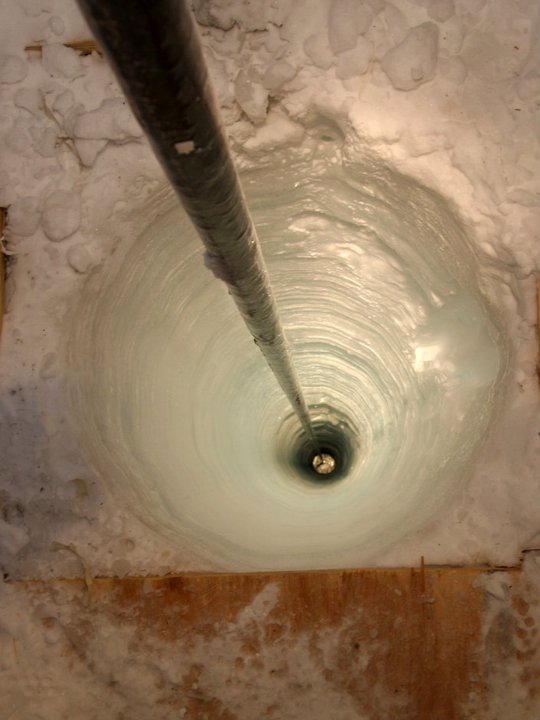
 Credit: IceCube Team
Credit: IceCube Team
Cool Science
Deep below the surface of Antarctica, under the ancient, clear, pure dark ice more than 1400 meters down, is a strange place to do astronomy. But if you're hunting the elusive neutrino, it's one of the best sites on earth. Neutrinos, subatomic "ghost particles", are difficult to detect since they so rarely interact with matter, but an ambitious experiment called IceCube is trying to track them down. IceCube uses a large volume of the South Polar Ice sheet as a neutrino detector. IceCube deploys 5000 extremely sensitive light sensors distributed on 86 strings, which cover about 1 cubic kilometer at a depth of about 1400 meters. The picture above shows the final light sensor being lowered into place. The deep Antarctic ice is extremely dark and extremely pure. When neutrinos pass through the ice, interactions between the neutrinos and the ice nuclei produce high-speed particles called muons, which actually travel faster through the ice than light (but slower than light travels in vacuum). The muons produce a kind of "photonic boom" as they pass through the ice, generating a brief flash of faint blue light called Cherenkov radiation. The IceCube detectors, in their otherwise perpetual darkness, can detect these tiny flashes. IceCube recently made headlines when they found no correlation between neutrino detections and the occurrence of gamma-ray bursts, all but ruling out GRBs as a source of high energy cosmic rays. This helps point to a solution of the 100-year old mystery of the origin of cosmic rays, and suggests that these cosmic rays are probably produced by supermassive black holes at the centers of active galaxies.
Published: April 23, 2012
<
HEA Dictionary ● Archive
● Search HEAPOW
● Other Languages
● HEAPOW on Facebook
● Download all Images
● Education ● HEAD
>

Each week the HEASARC
brings you new, exciting and beautiful images from X-ray and Gamma ray
astronomy. Check back each week and be sure to check out the HEAPOW archive!
Page Author: Dr. Michael F. Corcoran
Last modified Tuesday, 27-Feb-2024 10:15:20 EST


